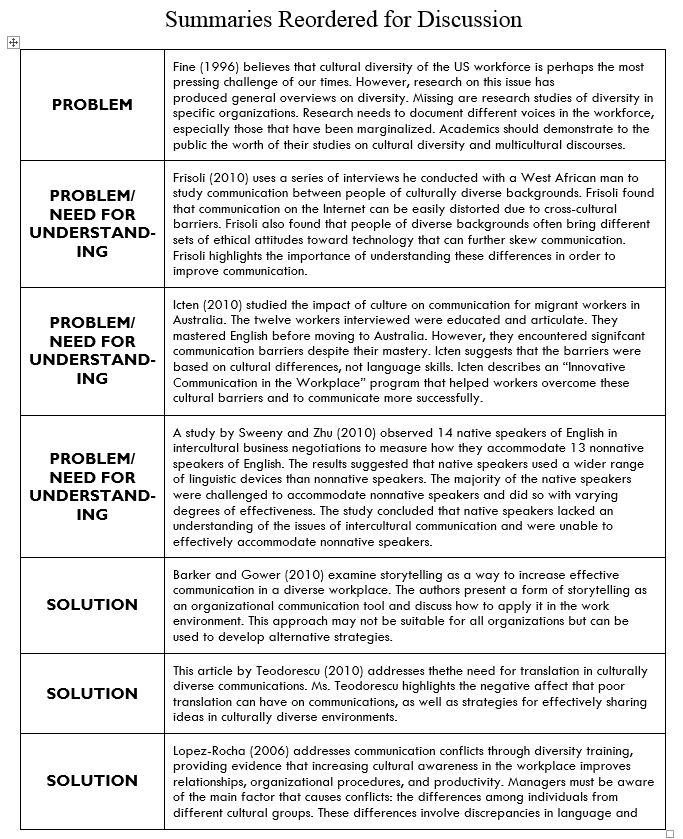
How to Write a Literature Review in 30 Minutes or Less
STEP 2: Reread & Reorder Summaries
In this step, reread the summaries and rearrange them for discussion. In other words, after studying the summaries, currently in alphabetical order, reorder them in a sequence that allows you to present them in a logical way. Rearranging the summaries into an organized list forces you to find connections among them.
For example, here are seven summaries about communication problems caused by cultural diversity in the workplace. Reading over them, note similarities and differences, then reorder them so that they flow in some type of sequence.
Keep in mind: There is no one universally correct sequence. The correct sequence is the one that you find and apply effectively.
The first entry by Barker and Gower concerns the use of storytelling. The annotation says the authors studied storytelling as a way to increase communication in a culturally diverse workplace. So, this source is presenting a strategy or a solution for our problem. Let’s label it SOLUTION.
| SOLUTION | Barker and Gower (2010) examine storytelling as a way to increase effective communication in a diverse workplace. The authors present a form of storytelling as an organizational communication tool and discuss how to apply it in the work environment. This approach may not be suitable for all organizations but can be used to develop alternative strategies. |
Next is a 1996 article by Fine that calls cultural diversity in the US workforce “perhaps the most pressing challenge of our times.” The article challenges academics to get busy and focus on marginalized voices that need assistance. It’s interesting that in the last century someone was already calling cultural diversity "the most pressing challenge of our times." Let’s label this a description of the PROBLEM.
| PROBLEM | Fine (1996) believes that cultural diversity of the US workforce is perhaps the most pressing challenge of our times. However, research on this issue has produced general overviews on diversity. Missing are research studies of diversity in specific organizations. Research needs to document different voices in the workforce, especially those that have been marginalized. Academics should demonstrate to the public the worth of their studies on cultural diversity and multicultural discourses. |
Next, Frisoli describes a series of Internet interviews he conducted with a West African man. Frisoli found that communication was blurred for two reasons: the medium—the Internet—and also because the two men had different attitudes toward technology and communication. Frisoli ends by underlining the need for flexibility in understanding and accepting how someone can be culturally different. Let’s label this one—PROBLEM. NEED FOR UNDERSTANDING.
| PROBLEM/ NEED FOR UNDER- STANDING |
Frisoli (2010) uses a series of interviews he conducted with a West African man to study communication between people of culturally diverse backgrounds. Frisoli found that communication on the Internet can be easily distorted due to cross-cultural barriers. Frisoli also found that people of diverse backgrounds often bring different sets of ethical attitudes toward technology that can further skew communication. Frisoli highlights the importance of understanding these differences in order to improve communication. |
This next entry is about a group of 12 workers who migrated to Australia. Despite having mastered English before going to Australia, these non-native professionals still encountered significant communication barriers. The barriers resulted from differences in culture, not language. A training program that focused on cultural differences seemed to help. We can also label this one-- PROBLEM. NEED FOR UNDERSTANDING.
| PROBLEM/ NEED FOR UNDER- STANDING |
Icten (2010) studied the impact of culture on communication for migrant workers in Australia. The twelve workers interviewed were educated and articulate. They mastered English before moving to Australia. However, they encountered signifcant communication barriers despite their mastery. Icten suggests that the barriers were based on cultural differences, not language skills. Icten describes an “Innovative Communication in the Workplace” program that helped workers overcome these cultural barriers and to communicate more successfully. |
So a clear pattern is starting to emerge: sources are describing either the problem or solutions for the problem. Note that two sources both say one key is to UNDERSTAND the differences in order to overcome them. Let’s continue.
The Lopez-Rocha entry focuses on a solution—diversity training. It presents evidence that increasing the cultural sensitivity of employees makes good things happen in the workplace, including overcoming communication barriers caused by cultural differenes. So, we label this a SOLUTION.
| SOLUTION | Lopez-Rocha (2006) addresses communication conflicts through diversity training, providing evidence that increasing cultural awareness in the workplace improves relationships, organizational procedures, and productivity. Managers must be aware of the main factor that causes conflicts: the differences among individuals from different cultural groups. These differences involve discrepancies in language and communication style, values, attitudes towards authority, and time—all of which can be addressed in diversity training. |
By now, soon as you look at the Sweeney and Zhu summary, you know where it will fit. The study documents problems that cultural diversity can cause in the workplace. Note that this author also mentions the need for native speakers to be flexible, understanding and accomodating to nonnative speakers. Again we will label this-- PROBLEM. NEED FOR UNDERSTANDING.
| PROBLEM/ NEED FOR UNDER- STANDING |
A study by Sweeny and Zhu (2010) observed 14 native speakers of English in intercultural business negotiations to measure how they accommodated 13 nonnative speakers of English. The results suggested that native speakers used a wider range of linguistic devices than nonnative speakers. The majority of the native speakers were challenged to accommodate nonnative speakers and did so with varying degrees of effectiveness. The study concluded that native speakers lacked an understanding of the issues of intercultural communication and were unable to effectively accommodate nonnative speakers. |
For the final entry by Teodorescu, it takes only a glance to see that the technique of translation has a place in the culturally diverse workplace and we have yet another-- SOLUTION.
| SOLUTION | This article by Teodorescu (2010) addresses the need for translation in culturally diverse communications. Teodorescu highlights the negative affect that poor translation can have on communications, as well as strategies for effectively sharing ideas in culturally diverse environments. |
To complete Step 2, we will ignore the original alphabetical order and rearrange the summaries according to PROBLEM—SOLUTION, which is the main pattern we observed. Keep in mind that this is just a rough arrangement that can be fine tuned later:
